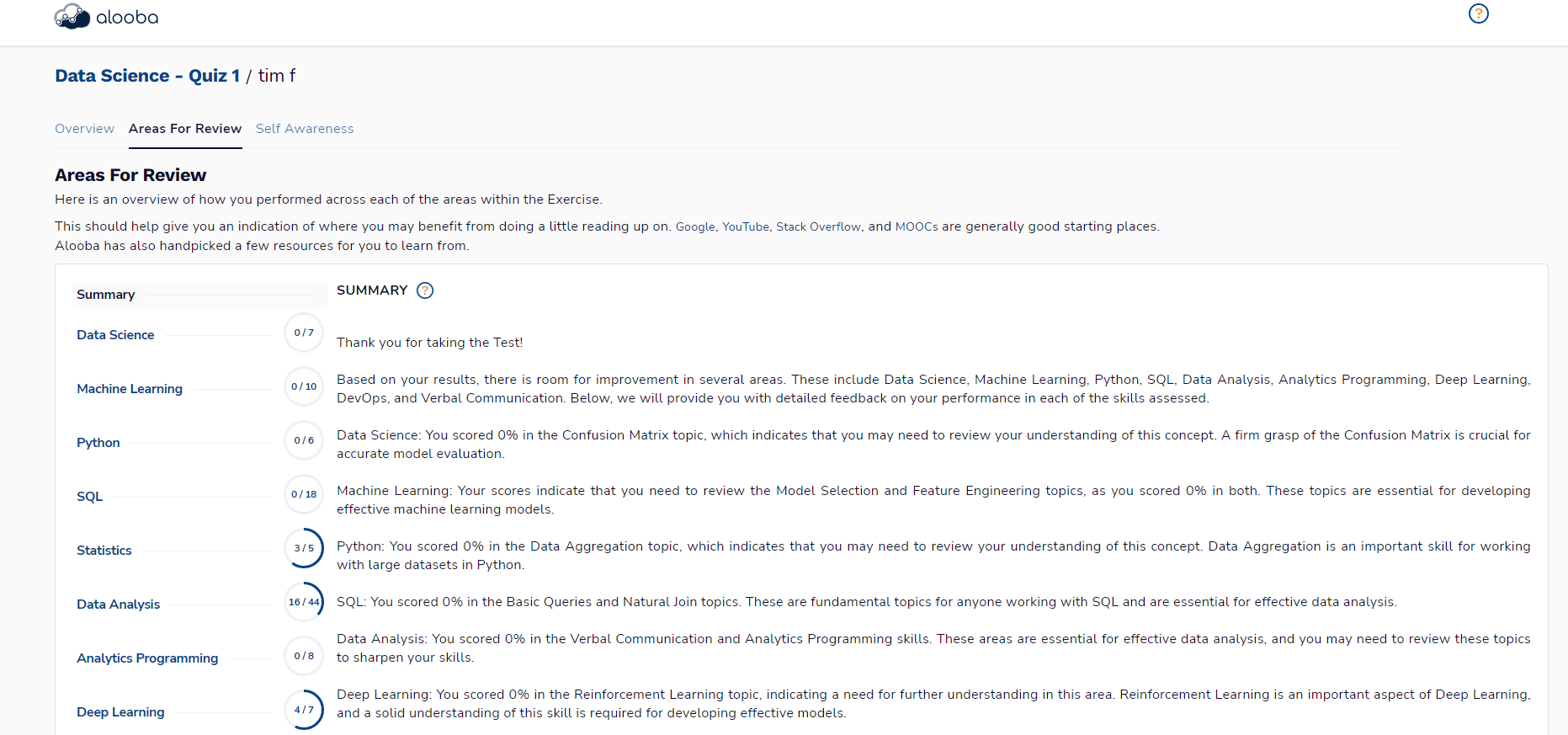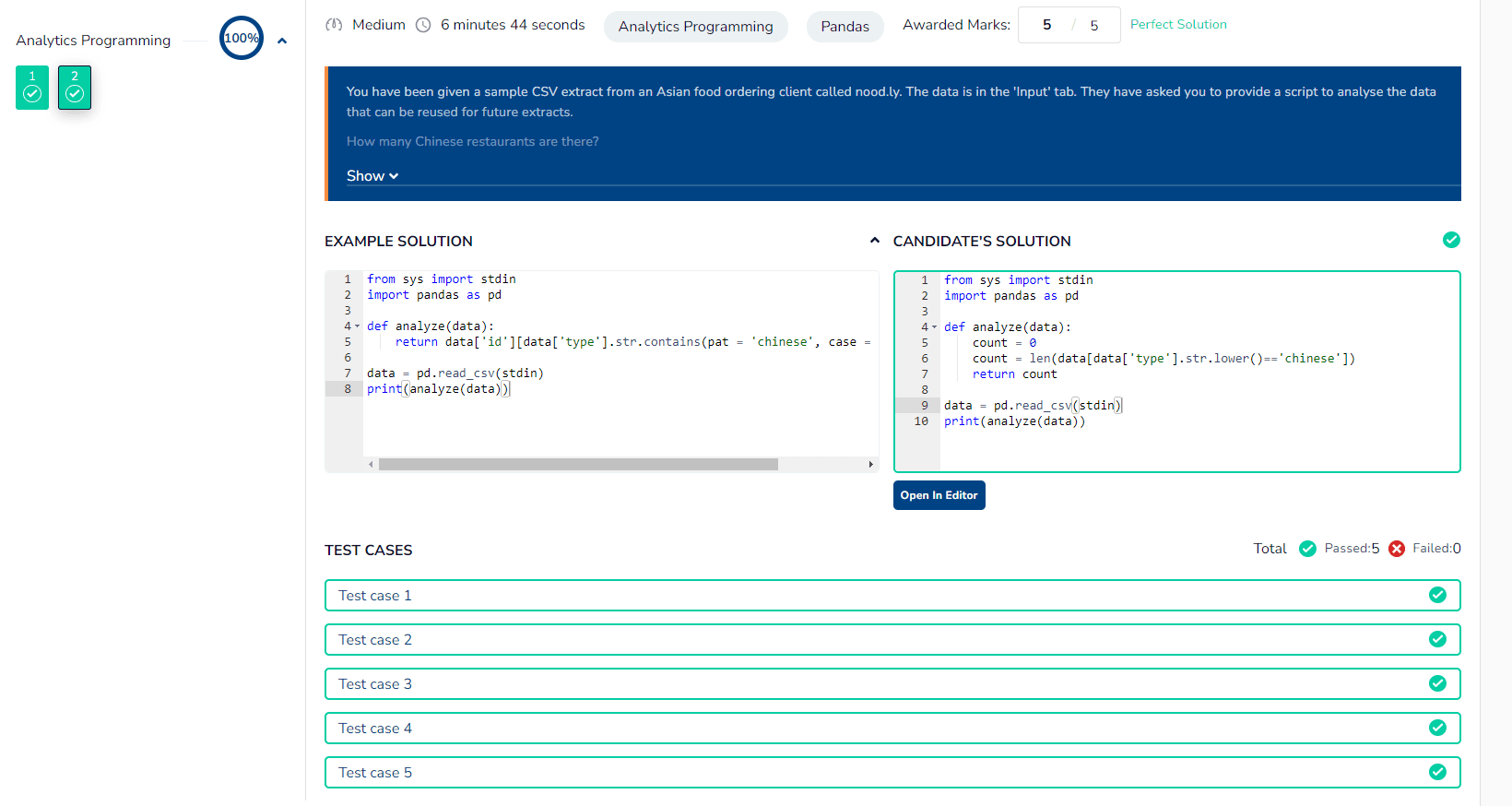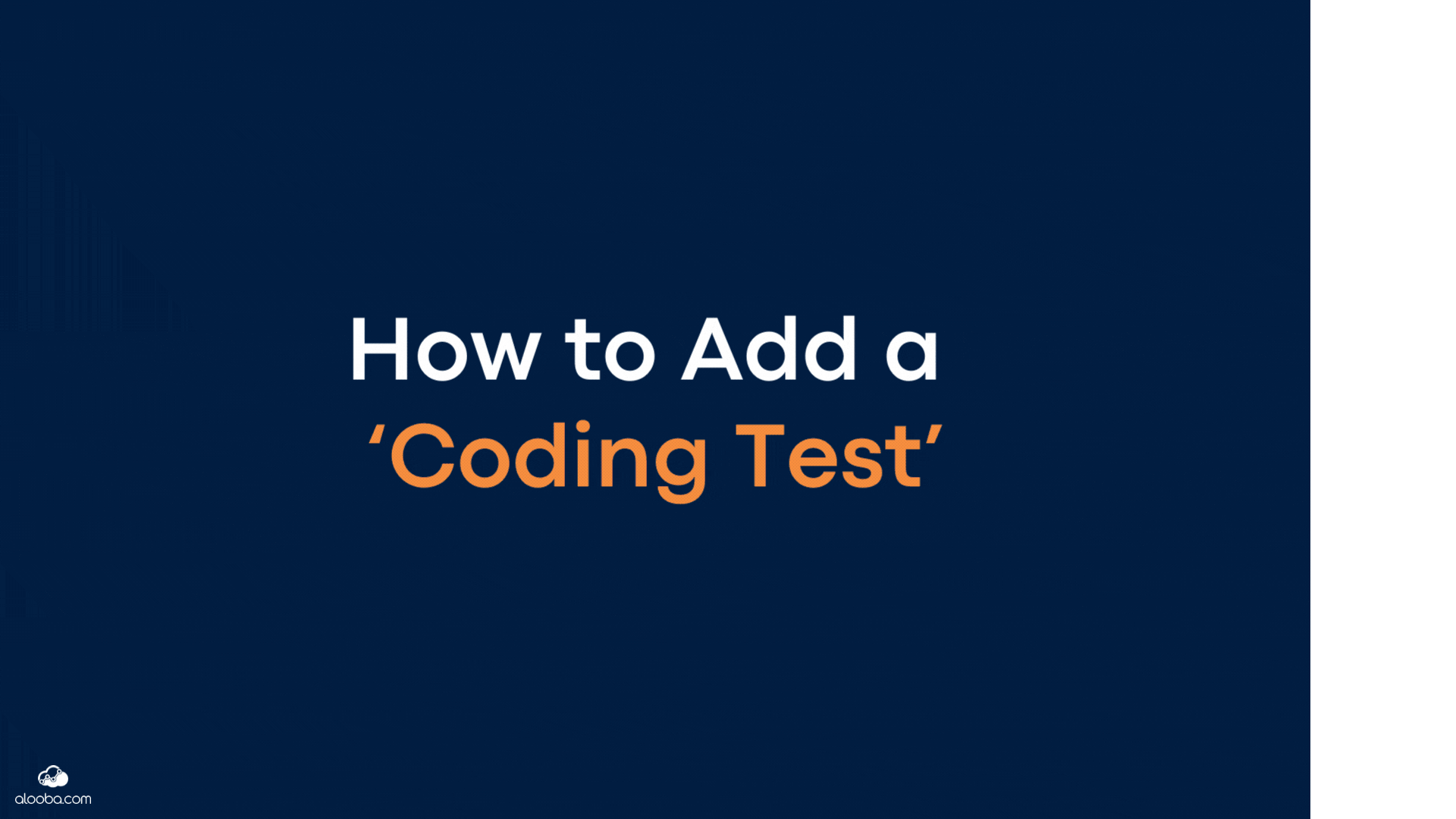Coding Test
This guide provides an overview of the Alooba Coding test, part of our 'Analytics Coding' test type. The Coding test is designed to evaluate candidates on their ability to write code to solve specific problems, making it an ideal assessment for roles that require strong programming skills.
Unlike other tests, the Coding test requires candidates to actively code in a selected programming language, allowing employers to see firsthand the candidate’s problem-solving abilities and technical proficiency.
The Coding test is part of the ‘Analytics Coding’ category, one of the six test options available on Alooba. The other test types include: ‘Concepts & Knowledge’ test, ‘Data Analysis’, ‘SQL’ test, ‘Free Response’ test, and ‘Personality Profiling’ test.
Features of the Coding Test
Language Selection:
You can choose to evaluate candidates in Python, R, or both. This flexibility allows you to tailor the test to the specific needs of your role and the skills of your candidates.
Number of Questions:
You can select between 2 to 8 questions for the test. This range allows you to adjust the test length and difficulty based on your hiring requirements.
Test Duration:
Set the test duration between 8 to 60 minutes. This feature helps you control the depth of the assessment, from quick screenings to more comprehensive evaluations.
Automatic Extra Time:
Optionally, you can allocate additional time to the test, giving candidates a buffer to complete their work.
Test Case Feedback:
Choose from four feedback options:
- None: No feedback provided during the test.
- Default Only: Feedback on whether the code passes a single default test case.
- Number Passing: Shows the number of test cases that pass.
- Full Detail: Detailed feedback on each test case, including which ones passed and which failed.
Difficulty Levels:
The Coding test offers three difficulty settings:
- Standard: Includes a mix of easy questions, some medium, and a few hard ones.
- Advanced: A balanced mix with some easy, plenty of medium, and a few hard questions.
- Expert: Primarily hard questions with some medium and a few easy ones.
I’m not an Alooba customer yet - how can I get access to the Coding test?
You can get started with Alooba by chatting with us or signing up directly for immediate access.
How can I pay for the Coding test?
When signing up for Alooba and using the Coding test, you can use any major credit card, and enterprise users can also pay via invoice.
Which roles is the Coding test suitable for?
The Coding test is suitable for any roles that require coding skills, particularly those in data science, data engineering, and software development.
Is this an online Coding test?
Yes, the Alooba test is delivered fully online, perfect for remote hiring and employees working from home.
Can I use the Coding test with other tests?
Yes absolutely, you can use the Coding test with any other Alooba test too, such as the Data Analysis Test, SQL test, one-way video interviews, and more.
Does the candidate need to install anything to complete the Coding test?
Absolutely not - they just complete the test in their browser of choice, like all the other Alooba tests.
How is the test structured?
Before starting the test, candidates will have the opportunity to take the test for a practice spin. This helps ensure that they are comfortable with the coding environment and know what to expect. Once they start the actual test, it’s a timed-test environment. The coding test includes the questions that you chose to select when setting up the test.
How is the test graded?
The grading for the Coding test works based on test cases. The candidate’s code is run against various test cases (input datasets). Points are awarded for each test case that passes, ensuring accurate measurement of skills and partial credit for minor mistakes.
Is there a time limit for each question?
No, there is no specific time limit for each individual question. Candidates will have the time for the test that you have set when configuring the test. They can then spend this time on whichever questions they like.
What kind of feedback does the candidate get during the test?
During the assessment, candidates can receive feedback depending on the feedback option chosen during test setup. This ranges from no feedback to detailed feedback on each test case.

What does the test environment look like for the candidate?
The candidate codes in a clean and simple environment, as shown below.

What do the candidate’s results look like for us? Do we see their code?
Yes absolutely, you get to see the candidate’s code, including seeing exactly how they arrived at their answer, how long they took, which test cases did/did not pass and why etc.

What are the benefits of using the Alooba Coding test?
The Alooba Coding test simplifies the evaluation of candidates' coding skills, ensuring they have the right skills for your role. No need to create, administer, or grade your own tests.
Do I get to pick which questions go into the Coding test?
Absolutely, you can pick whichever questions you’d like to include in your test from our library of expert-written coding questions. You can also add your own custom questions if you prefer.
Can I add my own coding questions?
Yes, you can add your own coding questions through the Alooba question bank.
How long does the Coding test take the candidate to complete?
The test time is customisable, so you can make it as long or short as you like. Typically, the overall assessment time for Alooba assessments ranges from 20-40 minutes when used as a screening tool, and 1-2 hours when used for a more in-depth assessment later in the hiring process.
I need my candidates to know either R or Python, I don’t mind which - is it possible to give candidates the choice of language?
Yes, if you are agnostic about which language the candidate is tested in, you can leave it up to them to decide. This helps the candidate put their best foot forward and take the test in their strongest language.
How do I set up a Coding Test on Alooba?
Setting up a Coding Test on Alooba is a straightforward process. Follow these steps:
- Create a new test: Go to the dashboard and click on “+ Create Assessment”.
- Select the test type: Choose “Analytics Coding” from the list of test options.
- Set the language: You can choose either Python, R, or both. If you choose both, candidates can decide which language to use.
- Determine the number of questions: Select between 2-8 questions for the test.
- Set the test duration: Choose a test duration between 8-60 minutes. You can also set automatic extra time if needed.
- Configure test case feedback: There are four feedback options: ‘None’, ‘Default Only’, ‘Number Passing’, ‘Full Detail’.
- Select difficulty level: Choose from three difficulty levels: ‘Standard’, ‘Advanced’, ‘Expert’.
- Finalise and publish: Review your settings and publish the test. Candidates will now be able to take the test online.

Can I customise the test further?
Yes, Alooba allows for extensive customization. You can tailor the test questions, timing, difficulty, and feedback options to best suit your hiring needs.
How do I add new questions to the Coding Test on Alooba?
Adding new questions to your Coding Test is straightforward. Follow these steps:
- Navigate to the question bank: After logging into your Alooba account, go to the question bank from your left-hand side bar menu.
- Add Question: On the top right corner of the page, click on the “+ Add Question” button.
- Select ‘Coding’: Choose “Coding” from the list of question types.
- Fill in the required fields: Question Title, Language, Topic, Question, Boilerplate/Starting Code, Example Solution, Test Cases, Difficulty, Time Allocated (minutes), Total Marks. Preview the question: Preview the question to see how candidates will view it on their screen.
- Click 'Publish Question': Once all details are entered, click ‘Publish Question’ to make it live.

Does the Coding test come with cheating protection?
Yes, the Coding test comes with Alooba’s advanced cheating protection, which includes AI text detection. Check out our complete guide to prevent candidates from cheating.
What’s an example of some Python code?
This example demonstrates how to perform data operations in base Python. It showcases the use of lists, dictionaries, list comprehensions, and basic functions for filtering and aggregation.
Here’s a great example of where using base Python is not going to be very efficient or easy - you can much more easily achieve the below using the pandas package in Python.
# Creating a list of dictionaries to represent the data
data = [
{'Name': 'Alice', 'Age': 24, 'City': 'New York', 'Salary': 50000},
{'Name': 'Bob', 'Age': 27, 'City': 'Los Angeles', 'Salary': 60000},
{'Name': 'Charlie', 'Age': 22, 'City': 'Chicago', 'Salary': 55000},
{'Name': 'David', 'Age': 32, 'City': 'Houston', 'Salary': 65000}
]
# Function to filter rows where Age is greater than 25
def filter_data(data):
return [person for person in data if person['Age'] > 25]
# Function to calculate average salary by city
def average_salary_by_city(data):
city_salary = {}
for person in data:
city = person['City']
if city in city_salary:
city_salary[city].append(person['Salary'])
else:
city_salary[city] = [person['Salary']]
# Calculate the average salary for each city
average_salary = {city: sum(salaries) / len(salaries) for city, salaries in city_salary.items()}
return average_salary
# Printing the original data
print("Original Data:")
for person in data:
print(person)
# Filtering the data
filtered_data = filter_data(data)
# Printing the filtered data
print("\nFiltered Data (Age > 25):")
for person in filtered_data:
print(person)
# Calculating the average salary by city
avg_salary = average_salary_by_city(data)
# Printing the average salary by city
print("\nAverage Salary by City:")
for city, salary in avg_salary.items():
print(f"{city}: {salary}")
What’s an example of some R code?
This example demonstrates how to perform some basic data science work in R (building a regression model), without installing any packages.
# Load the built-in dataset
data(mtcars)
# Display the first few rows of the dataset
head(mtcars)
# Calculate basic statistics for the dataset
summary(mtcars)
# Create a scatter plot of mpg (miles per gallon) vs. hp (horsepower)
plot(mtcars$hp, mtcars$mpg,
main="MPG vs Horsepower",
xlab="Horsepower",
ylab="Miles Per Gallon",
pch=19, col="blue")
# Perform a linear regression analysis
model <- lm(mpg ~ hp, data=mtcars)
# Display the summary of the linear regression model
summary(model)
# Add the regression line to the scatter plot
abline(model, col="red")
We Already Have Our Own Coding Test – Why Switch to Alooba?
While having your own coding test can be beneficial, switching to Alooba offers several distinct advantages that can enhance your hiring process. Here’s why you should consider making the switch:
-
Alooba: Tests are graded automatically using predefined test cases, ensuring consistency and objectivity. This eliminates human bias and errors, providing a fair assessment for all candidates.
-
Your Own Test: Manual grading can be subjective and time-consuming, leading to inconsistencies and potential biases.
-
Alooba: Includes advanced cheating prevention mechanisms, such as AI text detection and proctoring features, to ensure the integrity of the test.
-
Your Own Test: Cheating can be harder to detect and prevent without specialised tools.
-
Alooba: Easily scales with your hiring needs, allowing you to administer tests to multiple candidates simultaneously without any additional administrative burden.
-
Your Own Test: Managing and grading tests for a large number of candidates can be overwhelming and resource-intensive.
-
Alooba: Offers extensive customisation options, including the ability to choose question difficulty, test duration, and feedback settings. You can also select from a vast library of expert-written questions or add your own.
-
Your Own Test: Customising tests can be more challenging and time-consuming, especially if you need to frequently update or modify questions.
-
Alooba: Provides a built-in, user-friendly coding environment where candidates can write, execute, and test their code seamlessly.
-
Your Own Test: May require candidates to use their own development tools, leading to inconsistencies and potential technical issues.
-
Alooba: Offers detailed analytics and insights into candidate performance, helping you identify strengths and weaknesses and make data-driven hiring decisions.
-
Your Own Test: Gathering and analysing performance data can be cumbersome and less comprehensive.
-
Alooba: Streamlines the entire hiring process, from test administration to grading and feedback, saving you time and resources.
-
Your Own Test: Manual processes can slow down your hiring pipeline, leading to longer time-to-hire.
-
Alooba: Provides a smooth and professional testing experience, with immediate feedback options and a clean, intuitive interface.
-
Your Own Test: Candidates might face technical difficulties or inconsistencies, leading to a less positive experience.
Make Assessments a Part of Your Hiring Process
Integrating Alooba’s Coding Test into your hiring process ensures that you accurately evaluate the coding skills of your candidates in a structured and unbiased manner. With our testing platform, you can automate your recruitment efforts, save valuable time, and make data-driven hiring decisions.
Start using Alooba’s Coding Test today and elevate your hiring strategy.


